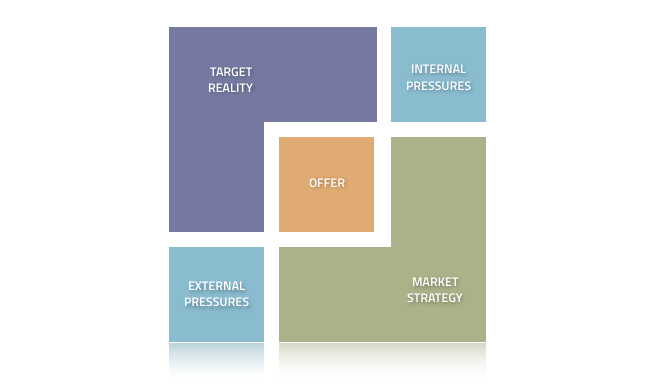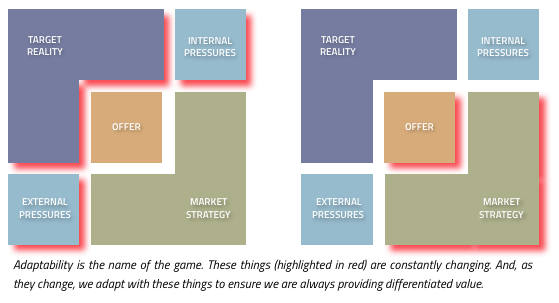What is Brand DNA?
People often talk about brand identity as being a brand’s DNA.
Just like in nature, the brand’s DNA (genotype) will dictate the brand’s offer (phenotype).
But, the objective of DNA is to help the organism become optimally adapted to an environment that is constantly changing. It is DNA’s ability to adapt that makes it such an apt metaphor for brands today.
To create DNA for a brand, we need to understand the environment that it will need to adapt to in order for it to flourish. We have created a proprietary model to define this environment, the Duffy Brand Model.

Brand DNA Model - Duffy Brand Model
Shaping the offer
This Brand DNA model is used to map the forces that shape the brand’s offer to the market. Some are internal, others external. All should be accounted for when developing a strategy. These forces are segmented into four main groups so we may better assess them and have our findings inform the brand strategy:
- Target Reality
- Who should our marketing activities be focused on, and what are their relevant:
- demographics and psychographics
- wants, needs, desires, and goals
- problems, challenges, and pains
- feelings, beliefs, perceptions
- options
- value requirements
- paths to purchase and touchpoints
- influencers
- favorite brands and other tribes they belong to?
- Who should our marketing activities be focused on, and what are their relevant:
- External Pressures
- What external opportunities and threats does the brand face in the market? What can be expected from political, economic, social, technological, legal, and environmental realms as well?
- Internal Pressures
- What are the relevant strengths and weaknesses of the company? How will factors like budgeting, legacy marketing beliefs and practices, corporate objectives and mandates, human resources, IT structure, operations, and personalities come into play?
- Market Strategy
- What is our strategy to differentiate the brand, focus the offer, and compete? How does this relate with regard to target, competitors, category, position, value proposition, selling points, naming, and profiling?
Maintaining the offer
If you consider the list above, it will become apparent that most of the items are evolving or changing regularly. Granted, some (e.g. consumer desires) change more quickly than others (e.g. political environment). But, the fact is that the market is perpetually in motion and so must the brand be. That is a stark reality in today’s markets, which move much faster and more globally than pre-internet markets.
To keep a brand in pace with the market, companies need to develop business processes to accommodate three objectives on a routine basis:
-
-
- mining of market insights (especially target insights)
- expert analysis and recommendations based on the findings
- adjustment of the offer (product, price, place, promotion) to
maintain value – how to add value to your offer? Check it out in our article.
-
The establishment of these functions in the organization signal a true marketing company as opposed to a production and sales company.
Why do we need these models and processes now?
A fair question. The short answer is that if you want to find a path for growth beyond where it is today, brand development and strategic marketing are the most proven way to do so.
Incremental improvements and scaling are possible indefinitely as long as the competitive landscape stays the same. But, will it? If you want to find new paths that offer more than incremental growth and also prepare for a more competitive market, then it makes sense to invest in brand strategy and strategic marketing functions now.
Think of it as a canoe race. Each tool used to compete is equivalent to another paddle in the water. If all the participants have three rowers, only you have the best three rowers, you win.
But, today, the gains that can be made with those three rowers are incremental, and it is likely the race will change soon with the entry of new competitors. What would happen if a competitor entered the market using these three tools, but then adds four more into the mix: strategic development of product, price, place, and promotion? That would be more like a canoe race where you had three rowers and the competitor had seven. No matter how good your three rowers are, they will not be able to compete against seven.

The exercise of modeling the variables that effect your business and putting processes in place to manage them can provide mid-sized companies with the added horsepower needed to realize accelerated growth and get to the next level ahead of any competitors.






